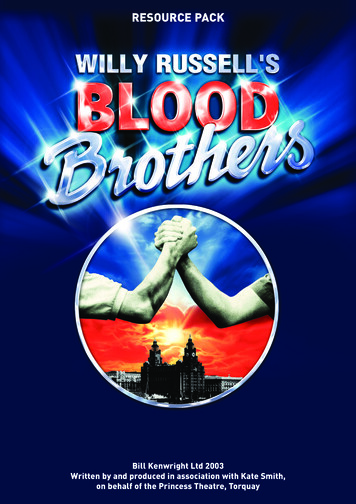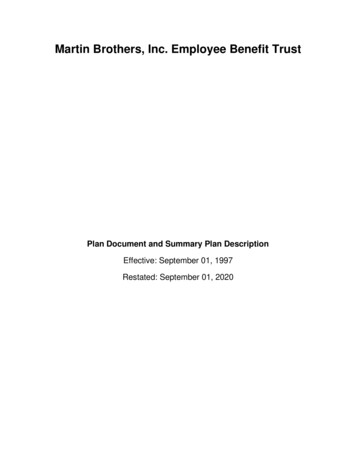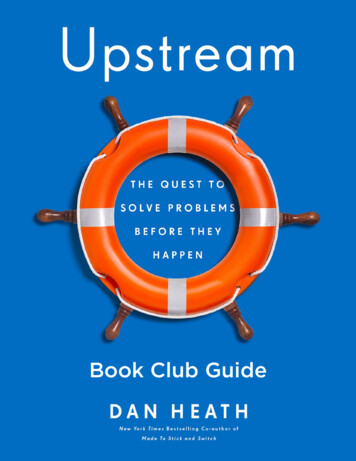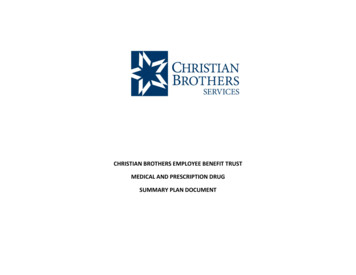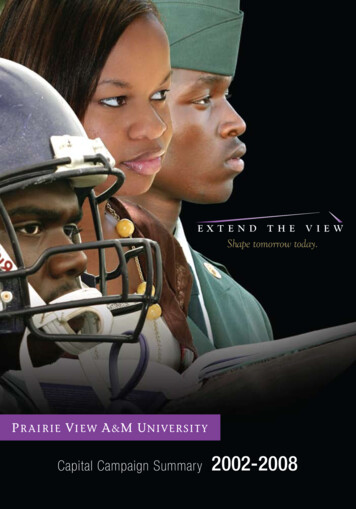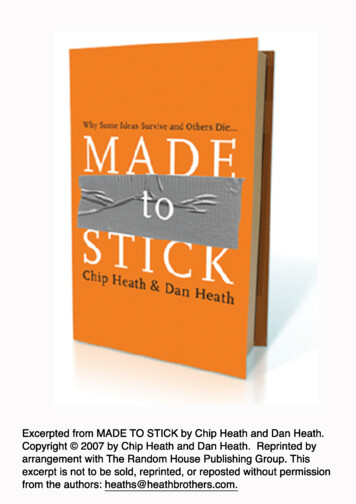
Transcription
Heat 1400064287 2p all r1.qxp8/29/0611:32 PMPage 3I N T R O D U C T I O NWHAT STICKS?friend of a friend of ours is a frequent business traveler. Let’scall him Dave. Dave was recently in Atlantic City for an important meeting with clients. Afterward, he had some time tokill before his flight, so he went to a local bar for a drink.He’d just finished one drink when an attractive woman approached and asked if she could buy him another. He was surprisedbut flattered. Sure, he said. The woman walked to the bar andbrought back two more drinks—one for her and one for him. Hethanked her and took a sip. And that was the last thing he remembered.Rather, that was the last thing he remembered until he woke up,disoriented, lying in a hotel bathtub, his body submerged in ice.He looked around frantically, trying to figure out where he wasand how he got there. Then he spotted the note:don’t move. call 911.A cell phone rested on a small table beside the bathtub. Hepicked it up and called 911, his fingers numb and clumsy from theice. The operator seemed oddly familiar with his situation. She said,“Sir, I want you to reach behind you, slowly and carefully. Is there atube protruding from your lower back?”A
Heat 1400064287 2p all r1.qxp48/29/0611:32 PMPage 4M A D E TO S T I C KAnxious, he felt around behind him. Sure enough, there was atube.The operator said, “Sir, don’t panic, but one of your kidneys hasbeen harvested. There’s a ring of organ thieves operating in this city,and they got to you. Paramedics are on their way. Don’t move untilthey arrive.”ou’ve just read one of the most successful urban legends of thepast fifteen years. The first clue is the classic urban-legend opening: “A friend of a friend . . .” Have you ever noticed that our friends’friends have much more interesting lives than our friends themselves?You’ve probably heard the Kidney Heist tale before. There arehundreds of versions in circulation, and all of them share a core ofthree elements: (1) the drugged drink, (2) the ice-filled bathtub, and(3) the kidney-theft punch line. One version features a married manwho receives the drugged drink from a prostitute he has invited to hisroom in Las Vegas. It’s a morality play with kidneys.Imagine that you closed the book right now, took an hourlongbreak, then called a friend and told the story, without rereading it.Chances are you could tell it almost perfectly. You might forget thatthe traveler was in Atlantic City for “an important meeting withclients”—who cares about that? But you’d remember all the important stuff.The Kidney Heist is a story that sticks. We understand it, we remember it, and we can retell it later. And if we believe it’s true, itmight change our behavior permanently—at least in terms of accepting drinks from attractive strangers.Contrast the Kidney Heist story with this passage, drawn from apaper distributed by a nonprofit organization. “Comprehensive community building naturally lends itself to a return-on-investment ra-Y
Heat 1400064287 2p all r1.qxp8/29/0611:32 PMINTRODUCTIONPage 55tionale that can be modeled, drawing on existing practice,” it begins,going on to argue that “[a] factor constraining the flow of resources toCCIs is that funders must often resort to targeting or categorical requirements in grant making to ensure accountability.”Imagine that you closed the book right now and took an hourlongbreak. In fact, don’t even take a break; just call up a friend and retellthat passage without rereading it. Good luck.Is this a fair comparison—an urban legend to a cherry-picked badpassage? Of course not. But here’s where things get interesting: Thinkof our two examples as two poles on a spectrum of memorability.Which sounds closer to the communications you encounter at work?If you’re like most people, your workplace gravitates toward the nonprofit pole as though it were the North Star.Maybe this is perfectly natural; some ideas are inherently interestingand some are inherently uninteresting. A gang of organ thieves—inherently interesting! Nonprofit financial strategy—inherently uninteresting! It’s the nature versus nurture debate applied to ideas: Are ideas borninteresting or made interesting?Well, this is a nurture book.So how do we nurture our ideas so they’ll succeed in the world?Many of us struggle with how to communicate ideas effectively, howto get our ideas to make a difference. A biology teacher spends anhour explaining mitosis, and a week later only three kids rememberwhat it is. A manager makes a speech unveiling a new strategy as thestaffers nod their heads enthusiastically, and the next day the frontline employees are observed cheerfully implementing the old one.Good ideas often have a hard time succeeding in the world. Yetthe ridiculous Kidney Heist tale keeps circulating, with no resourceswhatsoever to support it.Why? Is it simply because hijacked kidneys sell better than othertopics? Or is it possible to make a true, worthwhile idea circulate as effectively as this false idea?
Heat 1400064287 2p all r1.qxp68/29/0611:32 PMPage 6M A D E TO S T I C KThe Truth About Movie PopcornArt Silverman stared at a bag of movie popcorn. It looked out of placesitting on his desk. His office had long since filled up with fake-butterfumes. Silverman knew, because of his organization’s research, thatthe popcorn on his desk was unhealthy. Shockingly unhealthy, infact. His job was to figure out a way to communicate this message tothe unsuspecting moviegoers of America.Silverman worked for the Center for Science in the Public Interest (CSPI), a nonprofit group that educates the public about nutrition. The CSPI sent bags of movie popcorn from a dozen theaters inthree major cities to a lab for nutritional analysis. The results surprised everyone.The United States Department of Agriculture (USDA) recommends that a normal diet contain no more than 20 grams of saturatedfat each day. According to the lab results, the typical bag of popcornhad 37 grams.The culprit was coconut oil, which theaters used to pop their popcorn. Coconut oil had some big advantages over other oils. It gave thepopcorn a nice, silky texture, and released a more pleasant and natural aroma than the alternative oils. Unfortunately, as the lab resultsshowed, coconut oil was also brimming with saturated fat.The single serving of popcorn on Silverman’s desk—a snacksomeone might scarf down between meals—had nearly two days’worth of saturated fat. And those 37 grams of saturated fat werepacked into a medium-sized serving of popcorn. No doubt a decentsized bucket could have cleared triple digits.The challenge, Silverman realized, was that few people knowwhat “37 grams of saturated fat” means. Most of us don’t memorizethe USDA’s daily nutrition recommendations. Is 37 grams good orbad? And even if we have an intuition that it’s bad, we’d wonder if itwas “bad bad” (like cigarettes) or “normal bad” (like a cookie or amilk shake).
Heat 1400064287 2p all r1.qxp8/29/0611:32 PMINTRODUCTIONPage 77Even the phrase “37 grams of saturated fat” by itself was enough tocause most people’s eyes to glaze over. “Saturated fat has zero appeal,” Silverman says. “It’s dry, it’s academic, who cares?”Silverman could have created some kind of visual comparison—perhaps an advertisement comparing the amount of saturated fat inthe popcorn with the USDA’s recommended daily allowance. Thinkof a bar graph, with one of the bars stretching twice as high as theother.But that was too scientific somehow. Too rational. The amount offat in this popcorn was, in some sense, not rational. It was ludicrous.The CSPI needed a way to shape the message in a way that fully communicated this ludicrousness.Silverman came up with a solution.SPI called a press conference on September 27, 1992. Here’sthe message it presented: “A medium-sized ‘butter’ popcorn at atypical neighborhood movie theater contains more artery-clogging fatthan a bacon-and-eggs breakfast, a Big Mac and fries for lunch, and asteak dinner with all the trimmings—combined!”The folks at CSPI didn’t neglect the visuals—they laid out the fullbuffet of greasy food for the television cameras. An entire day’s worthof unhealthy eating, displayed on a table. All that saturated fat—stuffed into a single bag of popcorn.The story was an immediate sensation, featured on CBS, NBC,ABC, and CNN. It made the front pages of USA Today, the Los Angeles Times, and The Washington Post’s Style section. Leno and Letterman cracked jokes about fat-soaked popcorn, and headline writerstrotted out some doozies: “Popcorn Gets an ‘R’ Rating,” “Lights, Action, Cholesterol!” “Theater Popcorn is Double Feature of Fat.”The idea stuck. Moviegoers, repulsed by these findings, avoidedpopcorn in droves. Sales plunged. The service staff at movie housesgrew accustomed to fielding questions about whether the popcornC
Heat 1400064287 2p all r1.qxp88/29/0611:32 PMPage 8M A D E TO S T I C Kwas popped in the “bad” oil. Soon after, most of the nation’s biggest theater chains—including United Artists, AMC, and Loews—announced that they would stop using coconut oil.On StickinessThis is an idea success story. Even better, it’s a truthful idea successstory. The people at CSPI knew something about the world that theyneeded to share. They figured out a way to communicate the idea sothat people would listen and care. And the idea stuck—just like theKidney Heist tale.And, let’s be honest, the odds were stacked against the CSPI. The“movie popcorn is fatty” story lacks the lurid appeal of an organthieving gang. No one woke up in an oil-filled bathtub. The storywasn’t sensational, and it wasn’t even particularly entertaining. Furthermore, there was no natural constituency for the news—few of usmake an effort to “stay up to date with popcorn news.” There wereno celebrities, models, or adorable pets involved.In short, the popcorn idea was a lot like the ideas that most of ustraffic in every day—ideas that are interesting but not sensational,truthful but not mind-blowing, important but not “life-or-death.” Unless you’re in advertising or public relations, you probably don’t havemany resources to back your ideas. You don’t have a multimilliondollar ad budget or a team of professional spinners. Your ideas needto stand on their own merits.We wrote this book to help you make your ideas stick. By “stick,”we mean that your ideas are understood and remembered, and havea lasting impact—they change your audience’s opinions or behavior.At this point, it’s worth asking why you’d need to make your ideasstick. After all, the vast majority of our daily communication doesn’trequire stickiness. “Pass the gravy” doesn’t have to be memorable.When we tell our friends about our relationship problems, we’re nottrying to have a “lasting impact.”
Heat 1400064287 2p all r1.qxp8/29/0611:32 PMINTRODUCTIONPage 99So not every idea is stick-worthy. When we ask people how oftenthey need to make an idea stick, they tell us that the need arises between once a month and once a week, twelve to fifty-two times peryear. For managers, these are “big ideas” about new strategic directions and guidelines for behavior. Teachers try to convey themes andconflicts and trends to their students—the kinds of themes and waysof thinking that will endure long after the individual factoids havefaded. Columnists try to change readers’ opinions on policy issues.Religious leaders try to share spiritual wisdom with their congregants.Nonprofit organizations try to persuade volunteers to contribute theirtime and donors to contribute their money to a worthy cause.Given the importance of making ideas stick, it’s surprising howlittle attention is paid to the subject. When we get advice on communicating, it often concerns our delivery: “Stand up straight, make eyecontact, use appropriate hand gestures. Practice, practice, practice(but don’t sound canned).” Sometimes we get advice about structure:“Tell ’em what you’re going to tell ’em. Tell ’em, then tell ’em whatyou told ’em.” Or “Start by getting their attention—tell a joke or astory.”Another genre concerns knowing your audience: “Know whatyour listeners care about, so you can tailor your communication tothem.” And, finally, there’s the most common refrain in the realm ofcommunication advice: Use repetition, repetition, repetition.All of this advice has obvious merit, except, perhaps, for the emphasis on repetition. (If you have to tell someone the same thing tentimes, the idea probably wasn’t very well designed. No urban legendhas to be repeated ten times.) But this set of advice has one glaringshortcoming: It doesn’t help Art Silverman as he tries to figure out thebest way to explain that movie popcorn is really unhealthful.Silverman no doubt knows that he should make eye contact andpractice. But what message is he supposed to practice? He knows hisaudience—they’re people who like popcorn and don’t realize howunhealthy it is. So what message does he share with them? Compli-
Heat 1400064287 2p all r1.qxp108/29/0611:32 PMPage 10M A D E TO S T I C Kcating matters, Silverman knew that he wouldn’t have the luxury ofrepetition—he had only one shot to make the media care about hisstory.Or think about an elementary-school teacher. She knows hergoal: to teach the material mandated by the state curriculum committee. She knows her audience: third graders with a range of knowledge and skills. She knows how to speak effectively—she’s a virtuosoof posture and diction and eye contact. So the goal is clear, the audience is clear, and the format is clear. But the design of the messageitself is far from clear. The biology students need to understand mitosis—okay, now what? There are an infinite number of ways to teachmitosis. Which way will stick? And how do you know in advance?What Led to Made to StickThe broad question, then, is how do you design an idea that sticks?A few years ago the two of us—brothers Chip and Dan—realizedthat both of us had been studying how ideas stick for about ten years.Our expertise came from very different fields, but we had zeroed inon the same question: Why do some ideas succeed while others fail?Dan had developed a passion for education. He co-founded astart-up publishing company called Thinkwell that asked a somewhatheretical question: If you were going to build a textbook from scratch,using video and technology instead of text, how would you do it? Asthe editor in chief of Thinkwell, Dan had to work with his team to determine the best ways to teach subjects like economics, biology, calculus, and physics. He had an opportunity to work with some of themost effective and best-loved professors in the country: the calculusteacher who was also a stand-up comic; the biology teacher who wasnamed national Teacher of the Year; the economics teacher who wasalso a chaplain and a playwright. Essentially, Dan enjoyed a crashcourse in what makes great teachers great. And he found that, while
Heat 1400064287 2p all r1.qxp8/29/0611:32 PMPage 11INTRODUCTION11each teacher had a unique style, collectively their instructionalmethodologies were almost identical.Chip, as a professor at Stanford University, had spent about tenyears asking why bad ideas sometimes won out in the social marketplace of ideas. How could a false idea displace a true one? And whatmade some ideas more viral than others? As an entry point into thesetopics, he dove into the realm of “naturally sticky” ideas such asurban legends and conspiracy theories. Over the years, he’s becomeuncomfortably familiar with some of the most repulsive and absurdtales in the annals of ideas. He’s heard them all. Here’s a very smallsampler: The Kentucky Fried Rat. Really, any tale that involves ratsand fast food is on fertile ground. Coca-Cola rots your bones. This fear is big in Japan, but sofar the country hasn’t experienced an epidemic of gelatinous teenagers. If you flash your brights at a car whose headlights are off,you will be shot by a gang member. The Great Wall of China is the only man-made object thatis visible from space. (The Wall is really long but not verywide. Think about it: If the Wall were visible, then any interstate highway would also be visible, and maybe a fewWal-Mart superstores as well.) You use only 10 percent of your brain. (If this were true, itwould certainly make brain damage a lot less worrisome.)Chip, along with his students, has spent hundreds of hours collecting, coding, and analyzing naturally sticky ideas: urban legends,wartime rumors, proverbs, conspiracy theories, and jokes. Urban legends are false, but many naturally sticky ideas are true. In fact, perhaps the oldest class of naturally sticky ideas is the proverb—a nugget
Heat 1400064287 2p all r1.qxp128/29/0611:32 PMPage 12M A D E TO S T I C Kof wisdom that often endures over centuries and across cultures. Asan example, versions of the proverb “Where there’s smoke there’sfire” have appeared in more than fifty-five different languages.In studying naturally sticky ideas, both trivial and profound, Chiphas conducted more than forty experiments with more than 1,700participants on topics such as: Why Nostradamus’s prophecies are still read after 400 years Why Chicken Soup for the Soul stories are inspirational Why ineffective folk remedies persistA few years ago, he started teaching a course at Stanford called“How to Make Ideas Stick.” The premise of the course was that if weunderstood what made ideas naturally sticky we might be better atmaking our own messages stick. During the past few years he hastaught this topic to a few hundred students bound for careers asmanagers, public-policy analysts, journalists, designers, and film directors.To complete the story of the Brothers Heath, in 2004 it dawned onus that we had been approaching the same problem from differentangles. Chip had researched and taught what made ideas stick. Danhad tried to figure out pragmatic ways to make ideas stick. Chip hadcompared the success of different urban legends and stories. Dan hadcompared the success of different math and government lessons.Chip was the researcher and the teacher. Dan was the practitionerand the writer. (And we knew that we could make our parents happyby spending more quality time together.)We wanted to take apart sticky ideas—both natural and created—and figure out what made them stick. What makes urban legends socompelling? Why do some chemistry lessons work better than others?Why does virtually every society circulate a set of proverbs? Why dosome political ideas circulate widely while others fall short?In short, we were looking to understand what sticks.We adopted
Heat 1400064287 2p all r1.qxp8/29/0611:32 PMPage 13INTRODUCTION13the “what sticks” terminology from one of our favorite authors, Malcolm Gladwell. In 2000, Gladwell wrote a brilliant book called TheTipping Point, which examined the forces that cause social phenomena to “tip,” or make the leap from small groups to big groups, theway contagious diseases spread rapidly once they infect a certain critical mass of people. Why did Hush Puppies experience a rebirth?Why did crime rates abruptly plummet in New York City? Why didthe book Divine Secrets of the Ya-Ya Sisterhood catch on?The Tipping Point has three sections. The first addresses the needto get the right people, and the third addresses the need for the rightcontext. The middle section of the book, “The Stickiness Factor,” argues that innovations are more likely to tip when they’re sticky. WhenThe Tipping Point was published, Chip realized that “stickiness” wasthe perfect word for the attribute that he was chasing with his research into the marketplace of ideas.This book is a complement to The Tipping Point in the sense thatwe will identify the traits that make ideas sticky, a subject that was beyond the scope of Gladwell’s book. Gladwell was interested in whatmakes social epidemics epidemic. Our interest is in how effectiveideas are constructed—what makes some ideas stick and others disappear. So, while our focus will veer away from The Tipping Point’sturf, we want to pay tribute to Gladwell for the word “stickiness.” Itstuck.Who Spoiled Halloween?In the 1960s and 1970s, the tradition of Halloween trick-or-treatingcame under attack. Rumors circulated about Halloween sadists whoput razor blades in apples and booby-trapped pieces of candy. The rumors affected the Halloween tradition nationwide. Parents carefullyexamined their children’s candy bags. Schools opened their doors atnight so that kids could trick-or-treat in a safe environment. Hospitalsvolunteered to X-ray candy bags.
Heat 1400064287 2p all r1.qxp148/29/0611:32 PMPage 14M A D E TO S T I C KIn 1985, an ABC News poll showed that 60 percent of parentsworried that their children might be victimized. To this day, manyparents warn their children not to eat any snacks that aren’t prepackaged. This is a sad story: a family holiday sullied by bad people who,inexplicably, wish to harm children. But in 1985 the story took astrange twist. Researchers discovered something shocking about thecandy-tampering epidemic: It was a myth.The researchers, sociologists Joel Best and Gerald Horiuchi, studied every reported Halloween incident since 1958. They found no instances where strangers caused children life-threatening harm onHalloween by tampering with their candy.Two children did die on Halloween, but their deaths weren’tcaused by strangers. A five-year-old boy found his uncle’s heroin stashand overdosed. His relatives initially tried to cover their tracks bysprinkling heroin on his candy. In another case, a father, hoping tocollect on an insurance settlement, caused the death of his own sonby contaminating his candy with cyanide.In other words, the best social science evidence reveals that takingcandy from strangers is perfectly okay. It’s your family you shouldworry about.The candy-tampering story has changed the behavior of millionsof parents over the past thirty years. Sadly, it has made neighbors suspicious of neighbors. It has even changed the laws of this country:Both California and New Jersey passed laws that carry special penalties for candy-tamperers. Why was this idea so successful?Six Principles of Sticky IdeasThe Halloween-candy story is, in a sense, the evil twin of the CSPIstory.Both stories highlighted an unexpected danger in a common activity: eating Halloween candy and eating movie popcorn. Both sto-
Heat 1400064287 2p all r1.qxp8/29/0611:32 PMINTRODUCTIONPage 1515ries called for simple action: examining your child’s candy and avoiding movie popcorn. Both made use of vivid, concrete images thatcling easily to memory: an apple with a buried razor blade and a tablefull of greasy foods. And both stories tapped into emotion: fear in thecase of Halloween candy and disgust in the case of movie popcorn.The Kidney Heist, too, shares many of these traits. A highly unexpected outcome: a guy who stops for a drink and ends up one kidneyshort of a pair. A lot of concrete details: the ice-filled bathtub, theweird tube protruding from the lower back. Emotion: fear, disgust,suspicion.We began to see the same themes, the same attributes, reflectedin a wide range of successful ideas. What we found based on Chip’sresearch—and by reviewing the research of dozens of folklorists, psychologists, educational researchers, political scientists, and proverbhunters—was that sticky ideas shared certain key traits. There is no“formula” for a sticky idea—we don’t want to overstate the case. Butsticky ideas do draw from a common set of traits, which make themmore likely to succeed.It’s like discussing the attributes of a great basketball player. Youcan be pretty sure that any great player has some subset of traits likeheight, speed, agility, power, and court sense. But you don’t need allof these traits in order to be great: Some great guards are five feet tenand scrawny. And having all the traits doesn’t guarantee greatness: Nodoubt there are plenty of slow, clumsy seven-footers. It’s clear,though, that if you’re on the neighborhood court, choosing your teamfrom among strangers, you should probably take a gamble on theseven-foot dude.Ideas work in much the same way. One skill we can learn is theability to spot ideas that have “natural talent,” like the seven-footstranger. Later in the book, we’ll discuss Subway’s advertising campaign that focused on Jared, an obese college student who lost morethan 200 pounds by eating Subway sandwiches every day. The cam-
Heat 1400064287 2p all r1.qxp168/29/0611:32 PMPage 16M A D E TO S T I C Kpaign was a huge success. And it wasn’t created by a Madison Avenueadvertising agency; it started with a single store owner who had thegood sense to spot an amazing story.But here’s where our basketball analogy breaks down: In the worldof ideas, we can genetically engineer our players. We can create ideaswith an eye to maximizing their stickiness.As we pored over hundreds of sticky ideas, we saw, over and over,the same six principles at work.PRINCIPLE 1: SIMPLICITYHow do we find the essential core of our ideas? A successful defenselawyer says, “If you argue ten points, even if each is a good point,when they get back to the jury room they won’t remember any.” Tostrip an idea down to its core, we must be masters of exclusion. Wemust relentlessly prioritize. Saying something short is not the mission—sound bites are not the ideal. Proverbs are the ideal. We mustcreate ideas that are both simple and profound. The Golden Rule isthe ultimate model of simplicity: a one-sentence statement so profound that an individual could spend a lifetime learning to follow it.PRINCIPLE 2: UNEXPECTEDNESSHow do we get our audience to pay attention to our ideas, and how dowe maintain their interest when we need time to get the ideas across?We need to violate people’s expectations. We need to be counterintuitive. A bag of popcorn is as unhealthy as a whole day’s worth of fattyfoods! We can use surprise—an emotion whose function is to increase alertness and cause focus—to grab people’s attention. But surprise doesn’t last. For our idea to endure, we must generate interestand curiosity. How do you keep students engaged during the fortyeighth history class of the year? We can engage people’s curiosity overa long period of time by systematically “opening gaps” in their knowledge—and then filling those gaps.
Heat 1400064287 2p all r1.qxp8/29/0611:32 PMINTRODUCTIONPage 1717PRINCIPLE 3: CONCRETENESSHow do we make our ideas clear? We must explain our ideas interms of human actions, in terms of sensory information. This iswhere so much business communication goes awry. Mission statements, synergies, strategies, visions—they are often ambiguous tothe point of being meaningless. Naturally sticky ideas are full of concrete images—ice-filled bathtubs, apples with razors—because ourbrains are wired to remember concrete data. In proverbs, abstracttruths are often encoded in concrete language: “A bird in hand isworth two in the bush.” Speaking concretely is the only way to ensure that our idea will mean the same thing to everyone in our audience.PRINCIPLE 4: CREDIBILITYHow do we make people believe our ideas? When the former surgeon general C. Everett Koop talks about a public-health issue, mostpeople accept his ideas without skepticism. But in most day-to-daysituations we don’t enjoy this authority. Sticky ideas have to carrytheir own credentials. We need ways to help people test our ideas forthemselves—a “try before you buy” philosophy for the world ofideas. When we’re trying to build a case for something, most of us instinctively grasp for hard numbers. But in many cases this is exactlythe wrong approach. In the sole U.S. presidential debate in 1980 between Ronald Reagan and Jimmy Carter, Reagan could have citedinnumerable statistics demonstrating the sluggishness of the economy. Instead, he asked a simple question that allowed voters to testfor themselves: “Before you vote, ask yourself if you are better offtoday than you were four years ago.”PRINCIPLE 5: EMOTIONSHow do we get people to care about our ideas? We make them feelsomething. In the case of movie popcorn, we make them feel dis-
Heat 1400064287 2p all r1.qxp188/29/0611:32 PMPage 18M A D E TO S T I C Kgusted by its unhealthiness. The statistic “37 grams” doesn’t elicit anyemotions. Research shows that people are more likely to make a charitable gift to a single needy individual than to an entire impoverishedregion. We are wired to feel things for people, not for abstractions.Sometimes the hard part is finding the right emotion to harness. Forinstance, it’s difficult to get teenagers to quit smoking by instilling inthem a fear of the consequences, but it’s easier to get them to quit bytapping into their resentment of the duplicity of Big Tobacco.PRINCIPLE 6: STORIESHow do we get people to act on our ideas? We tell stories. Firefightersnaturally swap stories after every fire, and by doing so they multiplytheir experience; after years of hearing stories, they have a richer,more complete mental catalog of critical situations they might confront during a fire and the appropriate responses to those situations.Research shows that mentally rehearsing a situation helps us performbetter when we encounter that situation in the physical environment.Similarly, hearing stories acts as a kind of mental flight simulator,preparing us to respond more quickly and effectively.hose are the six principles of successful ideas. To summarize,here’s our checklist for creating a successful idea: a Simple Unexpected Concrete Credentialed Emotional Story. A clever observerwill note that this sentence can be compacted into the acronymSUCCESs. This is sheer coincidence, of course. (Okay, we admit,SUCCESs is a little corny. We could have changed “Simple” to “Core”and reordered a few letters. But, you have to admit, CCUCES is lessmemorable.)No special expertise is needed to apply these principles. There areno licensed stickologis
what it is. A manager makes a speech unveiling a new strategy as the staffers nod their heads enthusiastically, and the next day the front-line employees are observed cheerfully implementing the old one. Good ideas often have a hard time succeeding in the world. Yet the ridiculous Kidney Heist tale keeps circulating, with no resources
